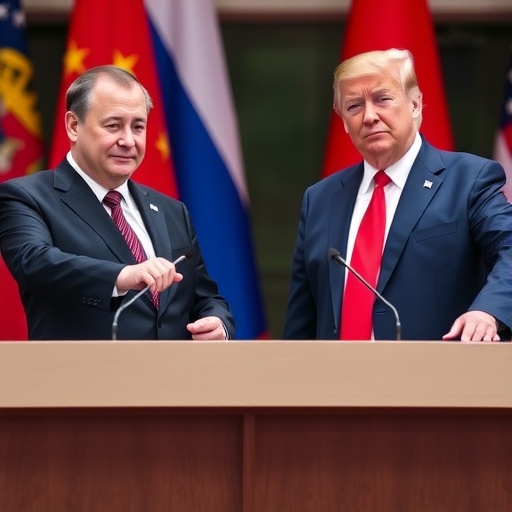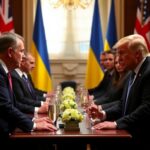Trump‘s Bold Outreach to China Amid Escalating Russia Tensions
In a surprising diplomatic pivot, President Donald Trump has publicly urged China to join forces with the United States in brokering a peace deal to end the protracted conflict between Russia and Ukraine, as he launches a pivotal five-day Asia trip. Speaking from the White House before departing for Malaysia, the president emphasized the need for Beijing’s influence over Moscow, stating, “China holds the key to unlocking peace in Europe—let’s work together to stop the suffering.” This request, timed just ahead of a crucial meeting with Chinese President Xi Jinping in South Korea, underscores the intricate web of global alliances Trump is navigating in his second term.
- Trump‘s Bold Outreach to China Amid Escalating Russia Tensions
- Unpacking the Russia Conflict: China’s Unique Leverage Over Moscow
- Mapping Trump’s Asia Trip: From Malaysia Markets to Seoul Summits
- Anticipating the Trump-Xi Meeting: Stakes for Global Stability
- Global Ripples and Future Pathways: What Comes After the Tour
The announcement comes at a critical juncture, with the Russia-Ukraine war entering its third year and causing widespread economic ripples. According to the United Nations, the conflict has displaced over 6 million people and inflicted damages estimated at $500 billion. Trump’s appeal to China highlights a strategic shift, recognizing Beijing’s economic leverage over Russia, which relies on China for more than 70% of its oil exports and key technology imports amid Western sanctions. This move is part of a broader effort to de-escalate tensions without direct U.S. military involvement, a hallmark of Trump’s “America First” foreign policy.
During his Asia trip, Trump aims to strengthen ties with key allies while addressing trade imbalances and security concerns in the Indo-Pacific region. The tour, which includes stops in Malaysia, Japan, and South Korea, is expected to cover bilateral trade agreements, North Korea’s nuclear threats, and now, unexpectedly, the Russia peace deal. White House officials revealed that preliminary discussions with Chinese counterparts have already begun via secure channels, signaling a potential thaw in U.S.-China relations strained by tariffs and tech rivalries.
Unpacking the Russia Conflict: China’s Unique Leverage Over Moscow
The ongoing war in Ukraine has reshaped global geopolitics, with Russia facing isolation from the West while deepening ties with China. President Trump’s call for China’s assistance in the peace deal is rooted in Beijing’s substantial sway over Russian President Vladimir Putin. Trade between China and Russia surged to $240 billion in 2023, a 26% increase from the previous year, according to China’s General Administration of Customs. This economic interdependence gives Xi Jinping unparalleled bargaining power—power that Trump is eager to harness.
Experts point to China’s neutral stance on the conflict as both an opportunity and a challenge. While Beijing has refrained from condemning Russia’s invasion, it has also called for a ceasefire and hosted peace talks in the past. “China’s role could be transformative if it pressures Russia to withdraw from occupied territories,” said Dr. Elena Vasquez, a senior fellow at the Brookings Institution. “Trump’s outreach acknowledges that diplomacy without China’s buy-in is incomplete.”
Historical context adds layers to this appeal. During Trump’s first term, he pursued a personal rapport with Putin, but relations soured over election interference allegations and the 2022 invasion. Now, with U.S. aid to Ukraine totaling $175 billion since the war began, Trump seeks a cost-effective resolution. Incorporating China into the equation could reduce American financial burdens while countering perceptions of U.S. unilateralism. However, skeptics warn that Beijing might use the overture to extract concessions on issues like Taiwan or semiconductor exports.
In detailed briefings, U.S. diplomats have outlined potential incentives for China, including eased restrictions on Huawei and collaborative infrastructure projects under the Belt and Road Initiative. These elements could form the backbone of negotiations, blending the Russia peace deal with broader economic diplomacy.
Mapping Trump’s Asia Trip: From Malaysia Markets to Seoul Summits
President Trump’s Asia trip is meticulously planned to blend economic outreach with security dialogues, starting in Kuala Lumpur, Malaysia, where he will address trade forums and meet with Prime Minister Anwar Ibrahim. Malaysia, a neutral player in great-power rivalries, serves as an ideal opener for discussions on supply chain resilience amid the Russia conflict’s disruptions. The U.S. exported $15 billion in goods to Malaysia last year, and Trump is pushing for enhanced deals in semiconductors and palm oil to offset inflation pressures at home.
Next, in Tokyo, Japan, Trump will consult with Prime Minister Fumio Kishida on bolstering the Quad alliance—comprising the U.S., Japan, Australia, and India—to counter Chinese assertiveness in the South China Sea. Japan, which has provided $12 billion in aid to Ukraine, shares U.S. concerns over Russian aggression and could amplify calls for China’s involvement in the peace deal. A joint statement is anticipated, highlighting coordinated sanctions if peace talks falter.
The trip culminates in Seoul, South Korea, where the high-profile meeting with Xi Jinping takes center stage. Hosted by President Yoon Suk-yeol, the summit will occur on the sidelines of the Asia-Pacific Economic Cooperation forum. Security is paramount, with over 5,000 U.S. troops stationed in South Korea amid North Korean provocations. Trump has hinted at linking the Russia discussions to denuclearization efforts on the Korean Peninsula, stating in a pre-trip interview, “Peace in Europe can inspire peace here—China, let’s make it happen.”
Logistically, the itinerary includes cultural engagements, such as a visit to the Demilitarized Zone, to humanize the diplomatic push. Air Force One’s route has been secured with refueling stops, ensuring Trump arrives energized for what could be a game-changing week.
Anticipating the Trump-Xi Meeting: Stakes for Global Stability
The marquee event of Trump’s Asia trip is his face-to-face with President Xi in South Korea, a rendezvous fraught with expectations for breakthroughs on the Russia peace deal. Past summits between the two leaders, like the 2017 Mar-a-Lago meeting, yielded tariff truces, but recent frictions over Taiwan and espionage charges have cooled relations. This encounter, however, carries unique weight due to the European crisis spilling into Asian energy markets—China’s LNG imports from Russia jumped 50% last year, per Reuters data.
Diplomatic insiders predict a multi-hour agenda, starting with bilateral trade (U.S.-China volume hit $690 billion in 2023) before pivoting to geopolitics. Trump may propose a “grand bargain”: Chinese mediation in Ukraine in exchange for U.S. restraint on tech export bans. Xi, facing domestic economic slowdowns with GDP growth at 4.7% in Q3, might see value in projecting China as a global peacemaker, enhancing its UN Security Council clout.
Quotes from allied leaders underscore the urgency. Japanese Foreign Minister Yoko Kamikawa remarked, “We support U.S. efforts to involve China—stability benefits all.” Meanwhile, European Union foreign policy chief Josep Borrell expressed cautious optimism: “If China tips the scales toward peace, it could end the bloodshed faster than any NATO escalation.”
Potential roadblocks include Russia’s insistence on territorial gains and Ukraine’s demand for full withdrawal. A China-brokered framework might involve phased ceasefires monitored by UN observers, drawing from the 2015 Iran nuclear deal model that Trump once criticized but could adapt.
Global Ripples and Future Pathways: What Comes After the Tour
As Trump’s Asia trip unfolds, the world watches for ripples that could redefine alliances. Success in enlisting China for the Russia peace deal might embolden multilateralism, potentially leading to a G20 special session on conflict resolution. Economically, de-escalation could lower global food prices—Ukraine’s grain exports, vital for Asia, have dropped 30% due to blockades, per the World Bank.
Critics, including some in Congress, fear over-reliance on China could undermine U.S. credibility with allies like NATO partners, who have committed 2% of GDP to defense spending. Yet, proponents argue it’s pragmatic realpolitik. Post-tour, Trump plans follow-up calls with Putin and Ukrainian President Volodymyr Zelenskyy, aiming for preliminary talks by year’s end.
Looking ahead, the initiative signals a Trump doctrine prioritizing deal-making over confrontation. If the Xi meeting yields commitments, it could pave the way for a 2025 peace accord, averting further escalation risks like cyber warfare or Arctic disputes. Stakeholders from Wall Street to Warsaw are bracing for outcomes that might just rewrite the post-Cold War order, with Trump‘s gamble at its core.
In the broader landscape, this outreach extends to climate cooperation—China and the U.S. together emit 40% of global CO2—and pandemic preparedness, tying security to shared challenges. As the tour progresses, updates from the State Department will clarify progress, but one thing is certain: the intersection of Asia trip dynamics and the Russia crisis is set to dominate headlines for months.









